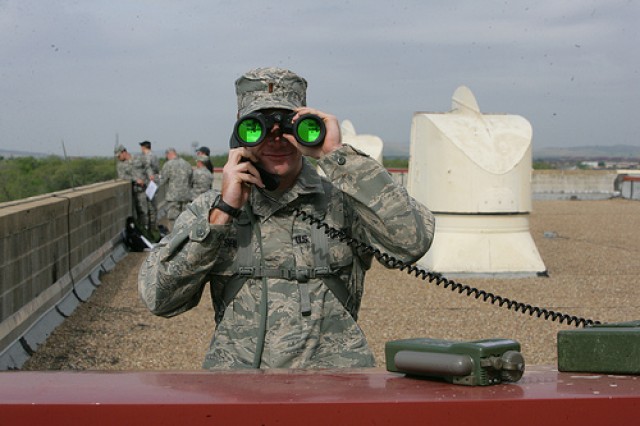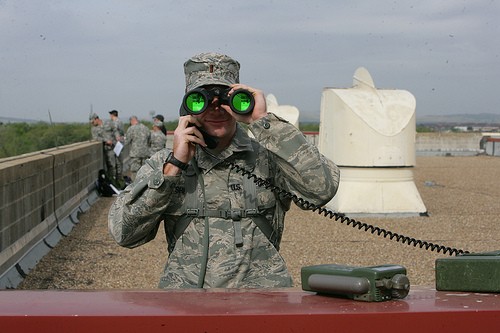FORT SILL, Okla.--Side by side, 2nd Lts. Eammon O'Shea and Michael Brittner are two of the first airmen to usher in the new Air Force Specialty Code: 13L, Air Liaison Officer. They are part of the first round of career ALOs to have no prior experience in the Air Force. And, being the first carries with it a lot of humility.
"How little we know. One of the biggest things I've learned is how much I don't know and how much I need to learn," said Brittner.
ALOs in general, have not always been a career but they are certainly not new to the battlefield. The liaisons worked in the Army Air Corps, coordinating air and ground operations in World War II and have worked alongside the Army in every conflict since. Until recently, however, it was a temporary duty carried out by pilots for up to three years before returning to their primary duty. This has changed as the demand to make ALOs a career position has increased with current operations in Iraq and Afghanistan.
ALOs work in a tactical air control party or TACP, primarily in an advisory role and as an advocate to the ground force commander ensuring effective fire power with U.S. and coalition Army combat maneuver units. The new ALOs will be stationed only at Army posts for the rest of their careers and will train with the Army units they will go to combat with.
Both men seem unphased by working with guys in Army green and recognize the only difference they've seen so far is the "lingo," or different terms for the same thing, between the two services. Even that is not a major concern for them. Obviously they will learn more about working with their sister service once they arrive at their duty stations and they both look forward to doing so.
"One of the main reasons I think they created my position is for that continuous leadership for the TACP community because before you had officers going in serving as ALOs for short periods of time so there wasn't that continuity and there wasn't that steady leadership that the TACP community needed and deserves," said O'Shea.
This change by the Air Force creates a dedicated career field for TACPs similar to the combat rescue officer for pararescue, special tactics officer for combat controllers and combat weather officers for battlefield weather airmen, according the Air Force liaison career description.
O'Shea and Brittner are excited to fill that need. After strict eyesight guidelines kept both from being pilots, they both decided to take the ALO career path to stay as close to battle as possible.
"I wanted to do something that actually mattered in the war. If I was in the military I wanted to do something that's actually military related," shared an impassioned Brittner.
The two just completed the Joint Fires Observer Course here April 16, the last course in their pipeline training. Before taking their final test to become JFOs, the two performed a call for fire from an overhead aircraft while they were posted on the rooftop of Snow Hall.
"Today, I talked to an F-16 on a radio and actually called in a target just like I would if I were a joint terminal attack controller, which was one of the most useful and confidence building things I've done in the whole pipeline," said Brittner.
They also took the Fire Support Coordinator Course on post.
As ALOs they are expected to know about every system the Air Force has and how to use them. Their expertise is not limited to putting bombs on target, it also includes surveillance from unmanned aircraft and even the use of space-based assets and cyber warfare. As far as their traditional counterparts, the two newly specialized airmen believe there are strengths and weaknesses to both.
"I hope we are a better medium between our enlisted guys and the Army because that's our main mission supporting our TACPs or JTACs that's what we're really there for," said Brittner.
Not all traditional ALOs are going away. Seventy percent of all ALOs will be career ALOs while 30 percent will continue to be pulled from the rated officer ranks.
Maj. Mike Meason, Joint Fires Observer Course officer in charge, said the advantage of having newly trained ALOs is, through training, they're gaining the basic understanding of what the capabilities, advantages and disadvantages of different services bring to the fight.
"As far as joint operations, the way we are I think it's awesome. There's no better way for the military to operate overall," said Brittner.
O'Shea agrees that a purple fight is the best kind.
"We've always been taught that when everything works in harmony that's when you're going to have the most efficient effects," he said.
The airmen will soon join their respective Army units and get ready for deployment.
Air Force officials hope to commission at least three ALO officers per month to reach an end strength of 259 career ALOs.


Social Sharing